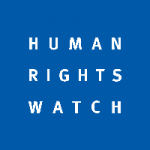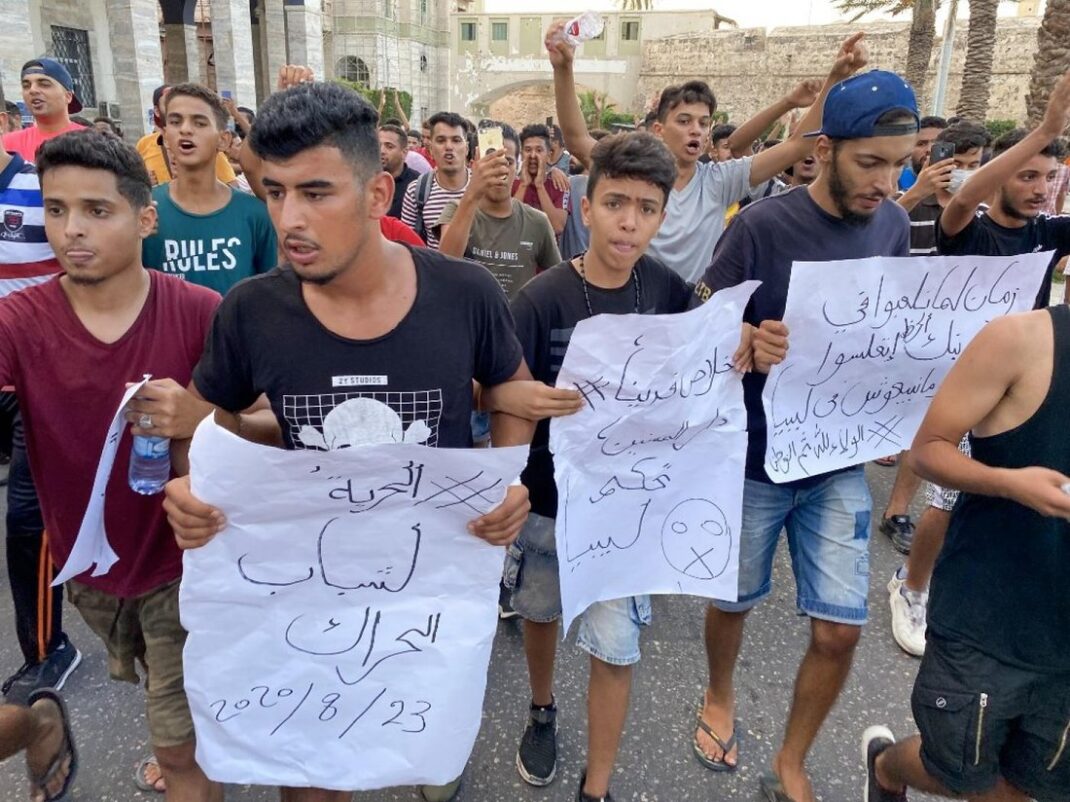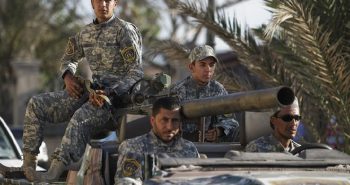 Armed groups in Tripoli linked with Libya’s Government of National Accord (GNA) used lethal force to disperse largely peaceful anti-corruption protests in late August 2020 and arbitrarily detained, tortured, and disappeared people in the capital, Human Rights Watch said today.
Armed groups in Tripoli linked with Libya’s Government of National Accord (GNA) used lethal force to disperse largely peaceful anti-corruption protests in late August 2020 and arbitrarily detained, tortured, and disappeared people in the capital, Human Rights Watch said today.
.
PART (II)
Witness Evidence
Because of fear of reprisals, those who spoke to Human Rights Watch have asked that their names be withheld.
Libya Alahrar TV, a Libyan satellite TV station, reported that a group of protesters harassed and attacked a TV crew from the channel on August 23 while they were preparing to cover the protests at Martyrs’ Square.
One Tripoli resident who attended the August 23 protest in Martyrs’ Square said that he observed a man in civilian clothes carrying a shotgun and shooting at protesters in the square before retreating toward armed groups who were stationed on the coastal road. This witness also observed a vehicle-mounted anti-aircraft weapon shooting at protesters:
When we saw violence take over, we wanted to leave the protest area as fast as possible, and almost ran into a pickup truck with a 14.5-millimeter anti-aircraft weapon. We had barely made it 6 or 7 meters when the shooting began. It was just before the call to prayers, around 7:30 p.m.
I was too preoccupied trying to make it out and so did not focus on any insignia other than it was a beige pickup truck. There were 10 or 12 people all wearing military uniforms with the exception of 1 militia member who was in civilian clothes.
Human Rights Watch reviewed video footage from the incident and corroborated the use of a vehicle-mounted 14.5-mm anti-aircraft weapon.
Another Tripoli protester said that protests on August 23 and 26 were met with violence, and that he recognized a member of Al-Nawasi Brigade who was shooting at protesters on August 23. He said protesters were mostly peaceful, with few exceptions:
On August 23, armed groups used anti-aircraft weapons against protesters and other weapons for around one-and-a-half hours. Initially they were shooting in the air. On August 26, a big convoy with over 50 military vehicles showed up at Martyrs’ Square that included Al-Nawasi Brigade, Bab Tajoura Brigade, and Tripoli Revolutionary Brigade, and I saw many people being arrested. Although the police were present during the demonstrations on these days they did not intervene when armed groups used machine guns and heavy weapons and arrested people under the eyes and ears of the Interior Ministry.
Al-Nawasi Brigade has power over police forces and they in return don’t have confidence to do anything.
A journalist covering the protests on August 23 said there was a lot of anger among the youth because of miserable living conditions and lack of opportunities in the country:
When I got to Martyrs’ Square at around 4 p.m., I saw people between 16 years and 40 years participate. People are ready to explode because there’s no water, no electricity, no cash or opportunities. People were calling for the removal of politicians and demanded an investigation into corruption allegations.
When the shooting started it was directed above the heads and not at the protesters, and only when protesters responded with swearing did the armed groups start to shoot directly at protesters. I saw injured people being taken away to the Tripoli Medical Center, but then they were transferred to another hospital.
Media Analysis
Multiple social media posts claimed that an armed group known as General Security in Ghot al-Shaal, west of Tripoli, shot and killed a protester, Sanad Omar al-Suwai’i al-Megrahi, after an argument at a checkpoint that the group manned.
Human Rights Watch reviewed two photos allegedly of al-Megrahi’s dead body that were posted on social media. Human Rights Watch could not verify the identity of the body or the cause or circumstances of death. The General Prosecutor should investigate the alleged killing, Human Rights Watch said.
Human Rights Watch also reviewed four photographs posted on social media that show an unidentified man with an injury to his right thigh that is consistent with an entry wound from a projectile fired from a firearm.
The photographs were first uploaded on August 23 at 7:53 p.m. by a journalist who said that the man was wounded after protesters where shot on Tariq Al-Shatt, the coastal road adjacent to Martyrs’ Square.
On the evening of August 23, a Facebook user published four consecutive videos, three of which were livestreams recording the area around Martyrs’ Square.
In these videos, gunfire, including from machine guns, can be heard. In the video posted at 7:51 p.m., at least three police vehicles can be seen in Martyrs’ Square making no apparent attempt to take any action as protestors flee from gunfire, but neither the origin nor direction of the fire can be established.
Two videos posted on Facebook on the evening of August 26 and morning of August 27, respectively, show men wearing camouflage clothing in and around Martyrs’ Square, carrying AK-style assault rifles, PK-style machine guns, and multiple pickup trucks mounted with ZPU-2 heavy machine guns and ZU-23 2 automatic cannons.
The ZPU-2 and ZU-23 2 weapons fire 14.5-mm and 23-mm caliber projectiles and are designed to be fired at low-flying aircraft. In the video posted on August 26 at 11:44 p.m., a convoy of dozens of vehicles carrying light and heavy machine guns, as well as an ZU-23 2 automatic canon, drives unimpeded past marked police vehicles.
Legal Standards
International standards stipulate that security forces should use the minimum necessary force at all times. In dispersing violent assemblies, firearms may only be used when other less-harmful means are not practicable, but even then must only be used to the minimum extent necessary.
Law enforcement officers may only intentionally make lethal use of firearms when strictly unavoidable to protect life. Live ammunition should not be used unless required to protect life or prevent serious injury.
The use of live ammunition when there is no imminent threat to life or risk of serious injury and the use of shotguns, machine guns, and other heavy weapons that fire over a wide area with the potential to harm anyone in their path violates international human rights standards governing law enforcement officials’ use of force.
The use of heavy machine guns and medium caliber projectiles, such as the 14.5-mm and 23-mm projectiles fired from anti-aircraft weapons, against people is likely to result in severe pain and suffering and thus may amount to excessive or unjustifiable force and a form of ill-treatment.
Given that shotguns firing multiple pellets, rubber or metal, are inherently inaccurate in nature with an indiscriminate impact, their use against demonstrators at any range should cease immediately, Human Rights Watch said.
Armed groups should also cease the use of machine guns, shotguns, and other heavy weapons, including anti-aircraft weapons, against protesters.
The UN guidance on “less-lethal” weapons in law enforcement states: “Multiple projectiles fired at the same time are inaccurate and, in general, their use cannot comply with the principles of necessity and proportionality. Metal pellets, such as those fired from shotguns, should never be used.”
Protester Demands and Response of Authorities
In a manifesto issued on August 20, the Harak Al-Shabab 23/08 movement pledged to peacefully address 11 key concerns, including the lack of electrical power, cooking gas, and cash in banks; social justice; the need for elections; ratification of the draft constitution that was finalized in October 2015 by an elected Constitution Drafting Assembly; expansions of the health and education budgets; and the need to end nepotism in public sector jobs.
On August 23 and August 27, Minister Bashagha accused “infiltrators” and members of armed groups who he said were not affiliated with the Interior Ministry of firing on protesters with machine guns and artillery that resulted in protesters being injured and the creation of “chaos and a new crisis.”
The August 27 statement accused armed groups of kidnapping and forcibly disappearing protesters. Since August 29, there have been no more demonstrations in Tripoli.
In a statement on August 26, the Interior Ministry stated that committees responsible for organizing protests needed to get advance permission, providing the date, time, and location based on Law 65/2012 on peaceful assembly.
On August 28, the Interior Ministry announced that it had apprehended one person allegedly responsible for using firearms against protesters.
In a flurry of decisions between August 26 and September 1, seemingly to stymie the public anger that’s driving the protests, GNA Prime Minister Fayez al-Serraj temporarily suspended Bashagha pending an investigation into the ministry’s handling of the protests and appointed a new defense minister and chief of staff of the Libyan army linked with the GNA.
On September 3, the Presidential Council re-instated Bashagha after conducting an investigation but did not release any details. The GNA also mandated that the Joint Operations Force in the Western Region under Osama Jweili and linked with the Defense Ministry would take over security of the capital in coordination with the Interior Ministry.
The GNA announced cash handouts under a family benefit program, mandated a committee to audit Health Ministry expenditures in 2019-2020, and ordered the Labor Ministry to review the status of unemployed people and create more public sector jobs. On September 1, the GNA also established a new ministry for housing and construction.
Governance and Conflict
Governance in Libya remains divided between two entities engaged in an armed conflict since April 2019 with the support of their respective foreign backers: the internationally recognized and Tripoli-based GNA and the rival Interim Government based in eastern Libya, affiliated with the armed group Libyan Arab Armed Forces under the command of General Khalifa Hiftar.
Hiftar has received military support from the United Arab Emirates, Jordan, Egypt, and Russia, including weapons and foreign fighters. Turkey is the main military backer of the GNA, which also has substantial foreign fighter support.
The conflict parties and foreign backers largely ignore a two-way arms embargo ordered by the UN Security Council in 2011 and renewed multiple times, with the tacit consent of Security Council.
The armed conflict in Tripoli and surrounding towns such as Tarhouna ended in June 2020 after GNA and affiliated forces pushed back Hiftar’s forces and their allies toward Sirte, a central coastal city 450 kilometers east of Tripoli.
Despite intensive international mediation efforts, Hiftar rejected on August 23 a temporary truce negotiated between the GNA Presidential Council and the Speaker of Parliament.
There are currently no armed confrontations between the parties.
_______________




